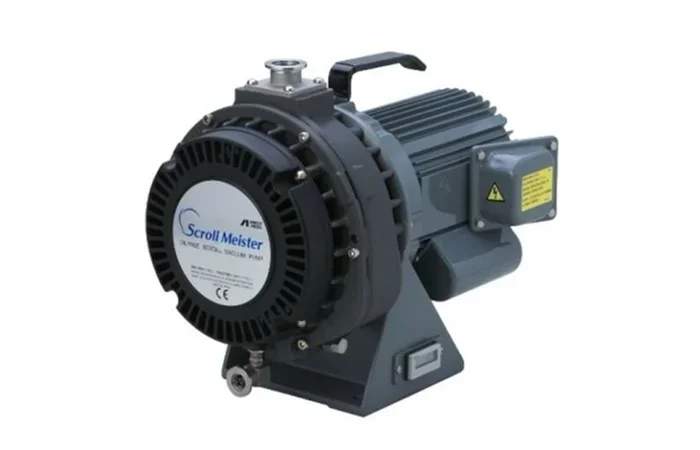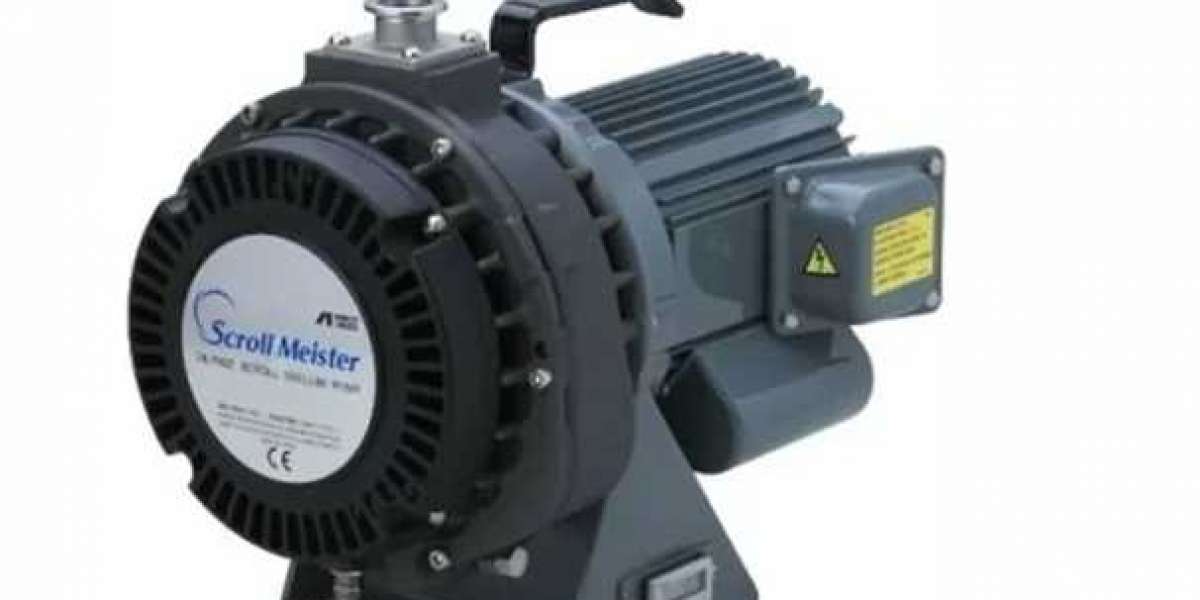Scroll pumps are positive displacement pumps used in a variety of industries including semiconductor manufacturing, vacuum coating, and research laboratories. Known for their high pumping speeds, low noise and low vibration, these pumps are ideal for applications requiring a clean and quiet environment. But how do scroll pumps work? In this comprehensive guide, we’ll explore the inner workings of a scroll pump and explain the principles behind its operation. Whether you are an experienced engineer or a curious newbie this guide will provide you with a detailed understanding of scroll pumps and their applications.
The Inner Workings of a Scroll Pump
Scroll pumps may seem like complex pieces of equipment, but their inner workings are actually quite fascinating. At the heart of a scroll pump is a pair of interlocking spirals, aptly named the orbiting and fixed scrolls. These scrolls fit together perfectly, creating pockets or chambers that move fluid from the inlet to the outlet.
As the pump operates, one scroll remains stationary while the other orbits around it in an eccentric motion. This action creates different-sized pockets between the scrolls which draw in and compress gas or liquid as they move. The fluid is then expelled through an exhaust port at higher pressure than when it entered.
What makes scroll pumps unique is their oil-free operation. Unlike traditional rotary vane pumps that rely on oil for lubrication and sealing, scroll pumps use only dry contact surfaces between the scrolls. This eliminates any risk of oil contamination in sensitive applications such as semiconductor manufacturing or vacuum drying processes.
Furthermore, because there are no contacting parts within the chamber itself, scroll pumps offer exceptional reliability and longevity. They require minimal maintenance compared to other types of pumps, reducing downtime and operating costs for businesses.
The simplicity and efficiency of scroll pump design make them ideal for various applications across industries. From HVAC systems to pharmaceutical processing equipment, these pumps can handle both gas and liquid pumping with ease. Their ability to achieve high vacuum levels also makes them popular choices in research laboratories where precise control over pressure is crucial.
To ensure optimal performance and extend their lifespan even further, regular maintenance is essential for scroll pumps. Regular inspections should be conducted to check for wear on seals or bearings and clean any accumulated debris that could impede proper functioning.
Understanding how a scroll pump works allows us to appreciate its many benefits – from its oil-free operation to its versatility across multiple industries. By providing efficient pumping solutions with low maintenance requirements, these innovative machines have become indispensable tools in many sectors today
Benefits of Using a Scroll Pump
When it comes to choosing the right pump for your application, there are many factors to consider. One option that stands out is the scroll pump. Known for its efficiency and reliability, scroll pumps offer several benefits that make them a popular choice in various industries.
First and foremost, scroll pumps are oil-free, which means they don't require lubrication like other types of pumps. This not only eliminates the need for regular oil changes but also reduces maintenance costs and downtime. Additionally, it ensures that no oil contamination occurs in sensitive applications such as semiconductor manufacturing or pharmaceutical production.
Another advantage of scroll pumps is their quiet operation. Unlike some traditional pumps that can be noisy and disruptive, scroll pumps operate smoothly with minimal vibration and noise levels. This makes them ideal for environments where noise reduction is important or where equipment needs to be placed close to work areas.
Scroll pumps also have a compact design, making them easy to install and integrate into existing systems. Their small footprint allows for flexible placement options even in limited spaces. Moreover, their lightweight construction makes them portable and convenient for on-site applications or fieldwork.
Furthermore, one key benefit of using a scroll pump is its high pumping speed capability combined with excellent vacuum performance. These features make it suitable for applications requiring rapid evacuation times or maintaining deep vacuum levels consistently over extended periods.
In addition to these advantages, scroll pumps are known for their energy efficiency compared to other pump types. They consume less power while delivering reliable performance, resulting in lower operating costs over time.
The benefits offered by scroll pumps - including oil-free operation, quietness,compact design,portability,effectiveness,and energy efficiency -make them an attractive choice across various industries ranging from research laboratories to industrial manufacturing processes.

Applications of Scroll Pumps
Scroll pumps are versatile machines that find applications in a wide range of industries. One of the primary uses of scroll pumps is in the field of semiconductor manufacturing. In this industry, maintaining clean and controlled environments is crucial, and scroll pumps play a vital role in achieving this.
Another important application of scroll pumps is in medical equipment such as MRI machines and vacuum ovens used for sterilization. These pumps provide efficient vacuum levels required for these processes, ensuring accurate readings and effective sterilization.
Scroll pumps are also widely used in laboratories for various purposes like drying samples, creating vacuum chambers, or operating gas analyzers. Their compact size and quiet operation make them ideal for use within enclosed spaces.
In the food processing industry, scroll pumps are employed for packaging products to extend their shelf life by removing air from containers before sealing them tightly. This helps prevent spoilage due to exposure to oxygen.
Furthermore, scroll pumps have become increasingly popular in the HVAC (Heating, Ventilation, and Air Conditioning) industry due to their efficiency at handling refrigerants. They can effectively circulate coolants while minimizing energy consumption.
These examples illustrate just a few of the many applications where scroll pumps prove invaluable across different sectors. As technology advances further, we can expect even more innovative uses for these powerful yet compact machines.
The Importance of Regular Maintenance for Scroll Pumps
Regular maintenance is a crucial aspect of keeping scroll pumps in optimal working condition. By performing routine maintenance tasks, you can extend the lifespan of your pump and ensure its efficient operation.
One important maintenance task is regularly inspecting the pump for any signs of wear or damage. This includes checking the seals, bearings, and other components for leaks or excessive wear. Any issues should be addressed promptly to prevent further damage.
Additionally, it is essential to clean the pump regularly to remove any debris or contaminants that may have accumulated inside. This helps maintain proper airflow and prevents clogs that could hinder performance.
Another vital aspect of maintenance is lubrication. Proper lubrication ensures smooth operation and reduces friction between moving parts. It's important to follow manufacturer guidelines regarding lubricant type and frequency of application.
Furthermore, regular calibration of the pump's pressure gauges and sensors is necessary to ensure accurate readings and reliable performance. This helps detect any deviations from normal operating conditions early on, allowing for timely adjustments or repairs.
By prioritizing regular maintenance for your scroll pump, you can maximize its efficiency, reliability, and lifespan.

Conclusion
Scroll pumps are an essential component in various industries, providing efficient and reliable vacuum or compression capabilities. Understanding how scroll pumps work can help users make informed decisions about their applications and maintenance requirements.
In this comprehensive guide, we have explored the inner workings of a scroll pump, highlighting its unique design that sets it apart from other types of pumps. The orbital motion of the scrolls creates a continuous flow, allowing for smooth operation with minimal noise and vibration.
One of the key benefits of using a scroll pump is its oil-free operation, eliminating the need for regular oil changes and reducing environmental impact. Additionally, scroll pumps offer high pumping speeds and ultimate pressures, making them suitable for a wide range of applications such as semiconductor manufacturing, scientific research, pharmaceutical production, and more.
To ensure optimal performance and longevity of your scroll pump, regular maintenance is crucial. This includes inspecting seals and bearings for wear or damage, cleaning filters to prevent clogging, checking for any leaks or unusual noises during operation. Following manufacturer's guidelines on maintenance intervals will help minimize downtime and maximize efficiency.
Overall, understanding how scroll pumps work empowers users to harness their capabilities effectively while ensuring proper care to extend their lifespan. By choosing the right type of scroll pump based on application requirements and performing routine maintenance tasks diligently, you can rely on these powerful devices to meet your vacuum or compression needs consistently.








